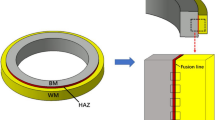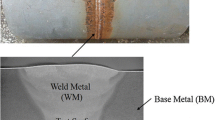Abstract
A numerical model is presented in this work that predicts the corrosion rate of weld joint. The model is able to track moving boundary of the corroding constituent of weld joint. The corrosion rates obtained from the model are compared with those estimated from mixed potential theory and two experimental techniques, namely immersion test and constant potential polarization test. The corrosion rate predicted using the model is within 10% of the estimate from the mixed potential theory, within 20% of that got from the immersion experiment and within 10% of that got from the constant potential polarization experiment for weld joint.










Similar content being viewed by others
References
C. Du, X. Li, P. Liang, Z. Liu, G. Jia, and Y. Cheng, Effects of Microstructure on Corrosion of X70 Pipe Steel in an Alkaline Soil, J. Mater. Eng. Perform., 2009, 18, p 216–220
M. Alizadeh and S. Bordbar, The Influence of Microstructure on the Protective Properties of the Corrosion Product Layer Generated on the Welded API, X70 Steel in Chloride Solution, Corros. Sci., 2013, 70, p 170–179
G. Zhang and Y. Cheng, Micro-electrochemical Characterization of Corrosion of Welded X70 Pipeline Steel in Near-Neutral pH Solution, Corros. Sci., 2009, 51, p 1714–1724
F.F. Eliyan and A. Alfantazi, Corrosion of the Heat-Affected Zones (HAZs) of API-X100 Pipeline Steel in Dilute Bicarbonate Solutions at 90 C-An Electrochemical Evaluation, Corros. Sci., 2013, 74, p 297–307
A. Stenta, S. Basco, A. Smith, C.B. Clemons, D. Golovaty, K.L. Kreider et al., One-Dimensional Approach to Modeling Damage Evolution in Galvanic Corrosion, Corros. Sci., 2014, 88, p 36–48
C. Wagner, Theoretical Analysis of the Current Density Distribution in Electrolytic Cells, J. Electrochem. Soc., 1951, 98, p 116–128
S. Aoki and K. Kishimoto, Prediction of Galvanic Corrosion Rates by the Boundary Element Method, Math. Comput. Model., 1991, 15, p 11–22
K.B. Deshpande, Validated Numerical Modelling of Galvanic Corrosion for Couples: Magnesium Alloy (AE44)–Mild Steel and AE44–Aluminium Alloy (AA6063) in Brine Solution, Corros. Sci., 2010, 52, p 3514–3522
K.B. Deshpande, Numerical Modeling of Micro-galvanic Corrosion, Electrochim. Acta, 2011, 56, p 1737–1745
K.B. Deshpande, Effect of Aluminium Spacer on Galvanic Corrosion Between Magnesium and Mild Steel Using Numerical Model and SVET Experiments, Corros. Sci., 2012, 62, p 184–191
J.W. Wilder, C. Clemons, D. Golovaty, K.L. Kreider, G.W. Young, and R.S. Lillard, An Adaptive Level Set Approach for Modeling Damage Due to Galvanic Corrosion, J. Eng. Math., 2014, 91, p 121–142
Standard A. G102-89. Calculation of Corrosion Rates and Related Information from Electrochemical Measurements, Annual Book of ASTM Standards, ASTM International, Philadelphia. 2004
W.S. Tait. An Introduction to Electrochemical Corrosion Testing for Practicing Engineers and Scientists: Clair, Racine, 1994
J. Donea, A. Huerta, J.-P. Ponthot, and A. Rodriguez-Ferran, Encyclopedia of Computational Mechanics Vol. 1: Fundamentals., Chapter 14: Arbitrary Lagrangian-Eulerian Methods, Wiley, New York, 2004
N.D. Tomashov, Development of the Electrochemical Theory of Metallic Corrosion, Corrosion, 1964, 20, p 7–14
H. Böhni (ed.), Corrosion in Reinforced Concrete Structures (Elsevier, 2005)
S. Nešić, Key Issues Related to Modelling of Internal Corrosion of Oil and Gas Pipelines—A Review, Corros. Sci., 2007, 49, p 4308–4338
S. Nesic, R. Nyborg, A. Stangeland et al., Mechanistic Modeling for CO2 Corrosion with Protective Iron Carbonate Films, Corrosion, 2001, 3, p 11–16
M. Nordsveen, S. Nešic, R. Nyborg et al., A Mechanistic Model for Carbon Dioxide Corrosion of Mild Steel in the Presence of Protective Iron Carbonate Films—Part 1: Theory and Verification, Corrosion, 2003, 59, p 443–456
Author information
Authors and Affiliations
Corresponding author
Rights and permissions
About this article
Cite this article
Lu, Y., Jing, H., Han, Y. et al. Numerical Modeling of Weld Joint Corrosion. J. of Materi Eng and Perform 25, 960–965 (2016). https://doi.org/10.1007/s11665-016-1910-1
Received:
Published:
Issue Date:
DOI: https://doi.org/10.1007/s11665-016-1910-1




